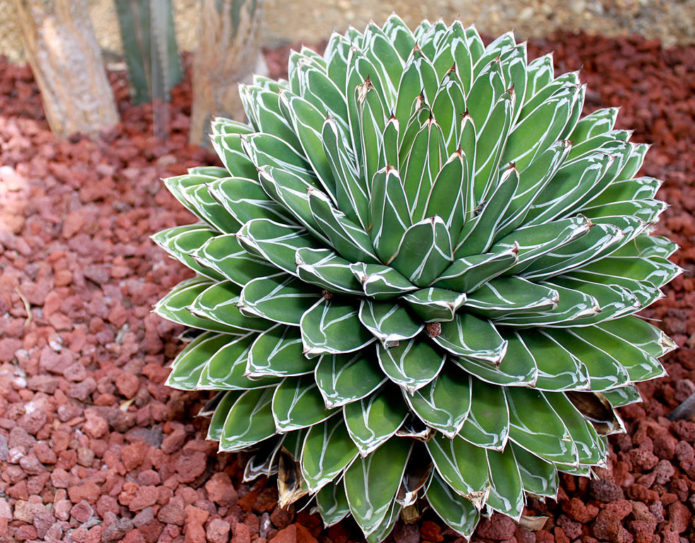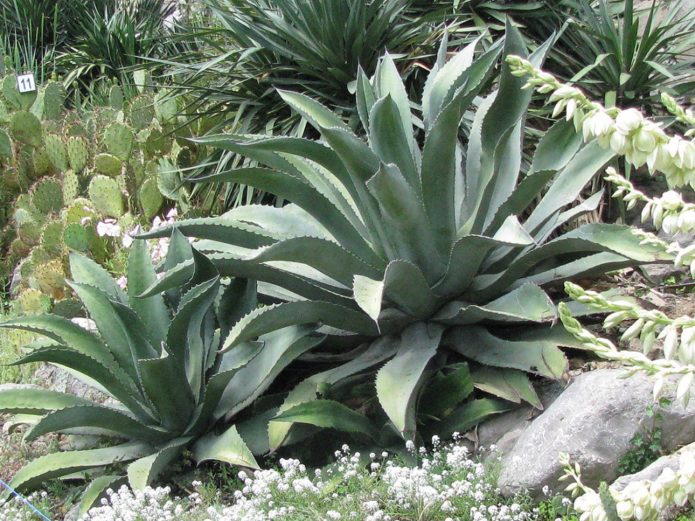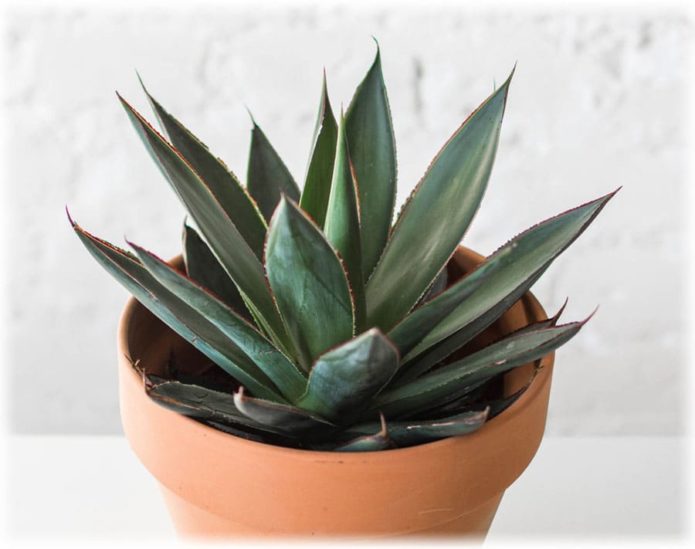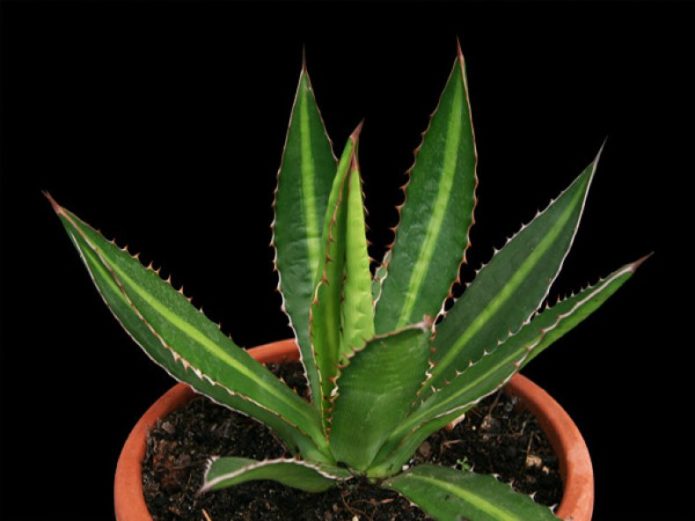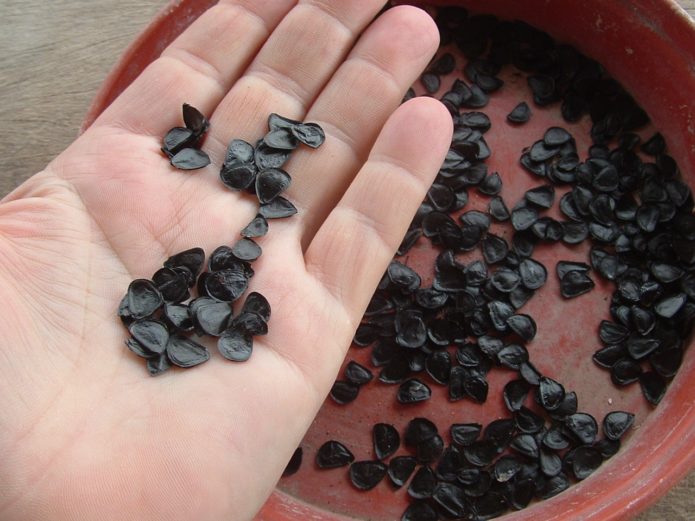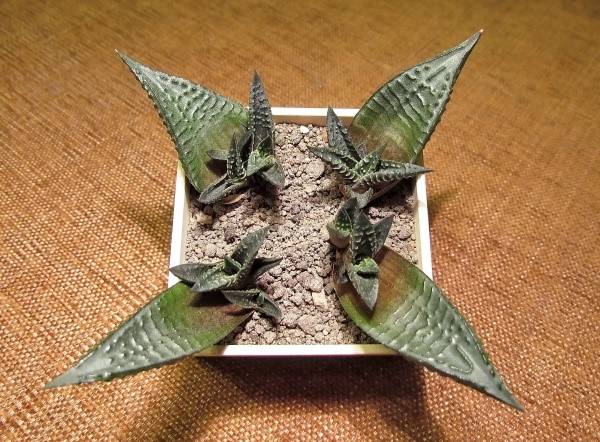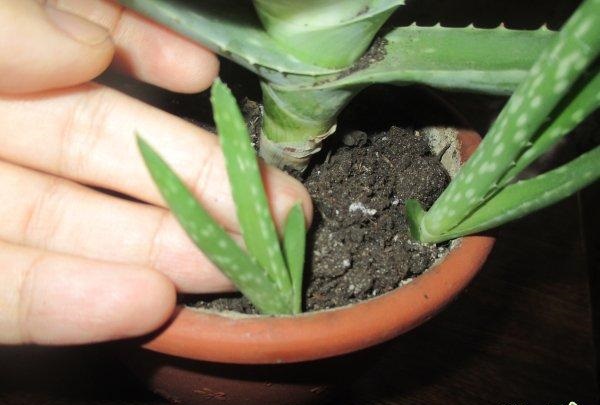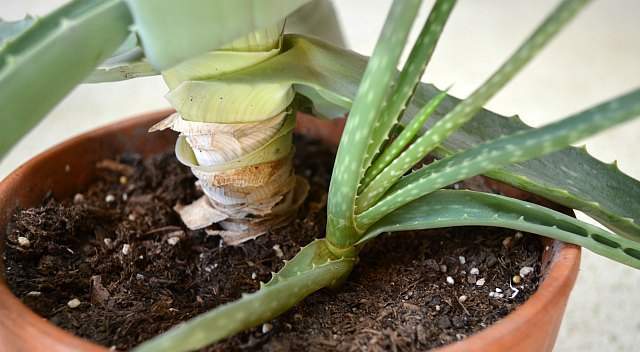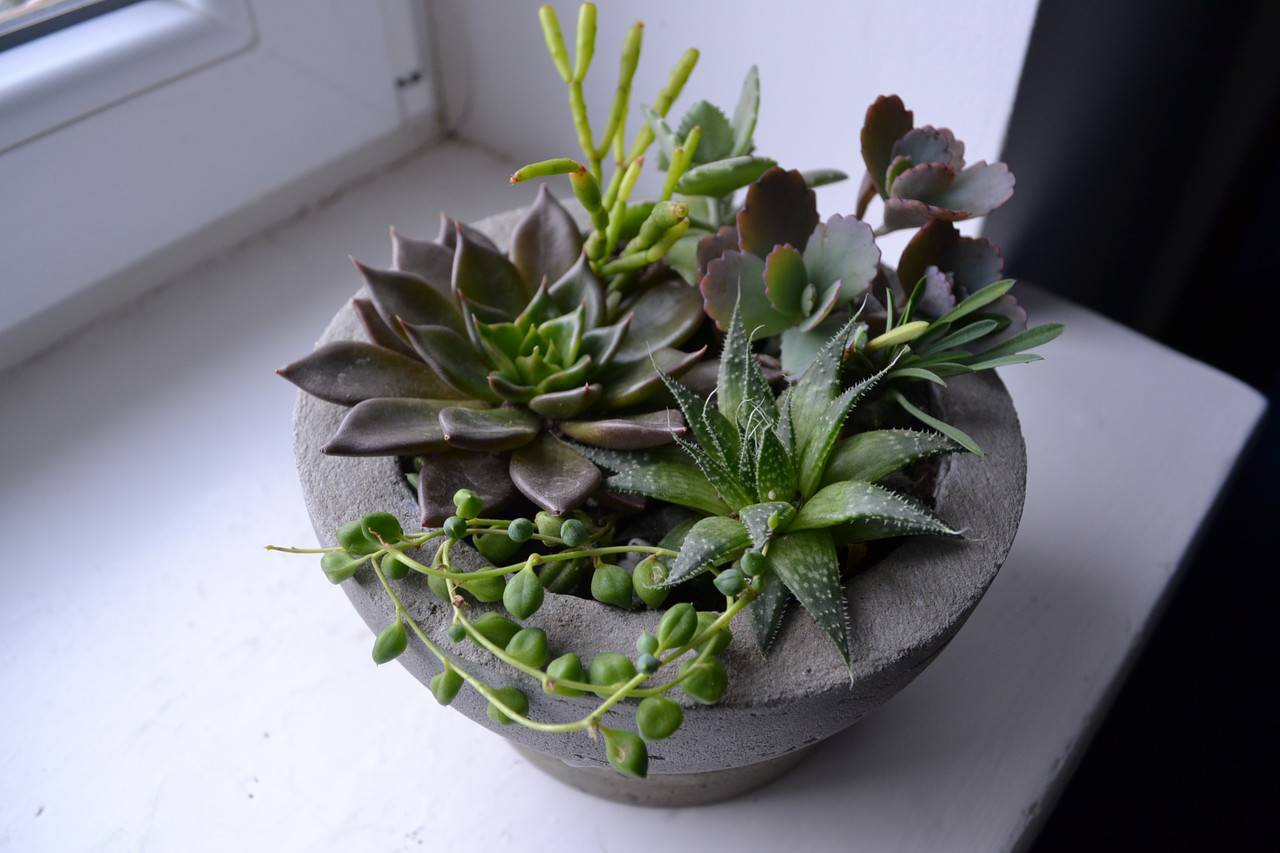Agave is a perennial herb from the category of succulents, belonging to the genus Asparagus of the Agave subfamily. In nature, it grows mainly in Mexico and South America in arid areas, more often in mountainous areas. In Russia, this succulent is actively cultivated as a decoration for winter gardens, parks, flower beds. Low-growing representatives are raised at home. Despite the lack of flowering, the plant fits effectively into any interior. And caring for agave is simple, due to its unpretentiousness.
Content
What does agave look like and why it has become popular with our gardeners
Agave is a perennial succulent, presented in the form of bushes that can grow up to 5 m in nature. Dwarf species are no more than 4 cm in height. Dense rosettes of agave are formed by fleshy (sometimes with thorns along the edges) green leaves with a gray or blue tint. They are grouped on a short stem. There are varieties with white or yellow stripes. Like most succulents, the leaf plates are waxed.
Agave belongs to centenarians due to its slow growth. In the natural environment, it blooms 1 time per life cycle, and in indoor conditions this is a rare phenomenon. When blooming, it starts up a long peduncle with a creamy yellow flower rosette at the end. The flowers do not bloom at the same time, but within 1-2 months. Then they die off and new shoots are formed. After that, oblong-shaped seed-fruits appear, collected in bunches.
Outwardly, agave looks like aloe, but the latter already has foliage and no such thorns.
Indoor species and varieties of agave with photo
Despite the wide variety of agave species (more than 300), several are grown at home. Common varieties:
- Queen Victoria's agave is a short variety up to 17 cm in height. It is a dense bushes that can grow up to 50 cm in diameter, consisting of thick, wide leaves, pointed at the ends. The leaves are deep green in color with white or yellow edging. In adulthood, the plant takes on the shape of a ball.
- Agave blue - the rosette includes dense xiphoid leaves of a greenish-blue color. Due to its ability to stretch up to one and a half meters in height, the plant is suitable for keeping in the halls and corridors of public institutions. In Mexico, it is grown commercially for tequila production.
- American agave is a bushy representative with an underdeveloped shoot and many dense succulent leaves with yellow spines on the sides and one long one at the top. The foliage is collected in a dense rosette that can reach a height of two meters. During flowering, it throws out a pedicel up to 8-9 m long.
- Whitish agave is a compact bush no more than 40 cm high. It has glossy broad leaves with a pointed edge. It owes its name to a white coating on the leaf plates.
- Agave filamentous is a low succulent, forming dense rosettes of flat leaves of olive-green color with filamentary white hairs on the sides.
- Agave frightening - forms a compact rosette (about 30 cm) of serrated rounded leaves. The foliage is dark green.
- Agave Tumi is a variety with lanceolate leaves and oval tips. Blue-green leaf plates with white edging. The rosettes extend up to 70 cm in height.
- Agave Funka is a species that does not have shoots, but only wide dense green leaves, grouped at the base. They have blue jagged edges.
What location will be comfortable for the plant
The succulent plant is not very picky about the conditions of detention, but prefers an abundance of light and a lot of space. The latter is due to the fact that agave grows intensively in width. Therefore, it is worth choosing a spacious windowsill for her. Since the sun's rays are vital for the full development of a plant, when choosing a location, preference is given to the southern and southeastern sides. As a last resort, you can place the pot next to a window facing west.
Bright light is encouraged, but this applies to mature shrubs. And young plants are kept in partial shade for the first years of life to avoid burns on the leaves. Agave calmly tolerates the coolness (just not a draft), so in the warm season it is recommended to take it out to the balcony. Until mid-autumn, it is allowed to completely relocate the succulent to fresh air (taking into account the climate of the region). It is important to protect the plant from rain: excess moisture can destroy it. With the onset of winter, the agave will not have enough light, so fluorescent lamps are installed nearby for additional lighting.
Table: optimal conditions for keeping agave depending on the season
| Season | Temperature | Humidity | Lighting |
| Spring Summer | + 23–39 ºC | Doesn't really matter, but you can't place the plant next to the battery | Bright |
| Autumn winter | + 15–19 ºC | Illuminated with lamps to create daylight hours at 10 o'clock |
Planting and transplanting
Agave purchased from a flower shop should be transplanted, but not immediately. Give her 2-3 days to acclimatize. Then they select a shallow pot with drainage holes at the bottom (preferably ceramic) and prepare the ground. You can buy a ready-made substrate for succulents and cacti, or mix it yourself. The main condition for the soil is good air and moisture permeability, a neutral environment.
The components for the soil mixture are taken in equal proportions:
- leaf compost;
- garden land;
- river sand.
A drainage layer (2–2.5 cm) of expanded clay, brick chips or fine gravel is poured into the bottom of the planting tank. It is not superfluous to add a handful of sand, which will serve as protection against root rot. When planting, the root collar is left open. After completing the procedure, the earth is not strongly compacted. And for stability, the sockets are lined with stones at the base. This will additionally protect the plant roots from sudden temperature jumps.
The first few days after transplanting, the agave should not be disturbed once again, it is worthwhile to water and feed it moderately. This is necessary for the plant to get used to a new place.
In the future, the agave is transplanted as the root system grows, when the old pot becomes cramped. This is usually done every year until the age of five, then every 3-4 years. The procedure is carried out in the spring.
Video on transplanting a flower into a suitable pot
Care
As a plant, agave is unpretentious, but this does not exclude the observance of certain rules for care. They will vary depending on the period. So, in spring - summer, the plant is in a phase of active growth and development, and in autumn - in winter it enters a dormant stage.
With a successful combination of circumstances, agave blooms can be seen once in 15–20 years of growth. Immediately after flowering, the plant dies, but has time to leave offspring, which begin to actively develop.
Watering and feeding
Agave is watered moderately throughout the spring-summer period once a week. In this case, boiled and settled water is used. The ideal option is rain or river water. They try not to get it on the leaves (this leads to burns). They also do not allow the creation of swampiness, therefore they moisten as the top layer of the soil dries up. It is not necessary to spray the plant. In autumn and winter, the frequency of irrigation is reduced to a minimum - irrigate only when the upper soil layer is completely dry.
Top dressing begins in early spring with a frequency of 2 times a month. At the beginning of autumn, they switch to the schedule - once a month, and with the onset of winter, they completely stop fertilizing. They use complex mineral compositions intended for succulents and cacti, with a low nitrogen content. For dosages, they are guided by the attached instructions.
Agave does not need pruning and pinching of leaves.
Table: mistakes in care and their correction
In the process of caring for agave, mistakes are likely on the part of the grower, which lead to certain negative consequences.
| Painful manifestations | Causes | Correction methods |
| Excessive stretching of leaves | Lack of light | Change the location of the flower |
| Leaves wither and shrivel | Excess moisture | Normalize the irrigation regime |
| The foliage turns yellow at the ends | Dry air or too much calcium in the soil | They put the succulent on a pallet with wet moss or place a container of water next to it. Less often fed |
| Leaves lose their meatiness and juiciness | Lack of moisture | Increase the amount of hydration |
| Dark spots appear on the leaf plates | Prolonged exposure of the plant to direct sunlight | Create light shading |
| The growth of the outlet is inhibited | Little lighting | Move the pot closer to the window |
Diseases and pests
Agave is extremely rare. The most common ailment is root and stem rot.... The reason is high air humidity at a consistently low temperature or lack of drainage. The first symptoms of damage are dark spots and streaks on the foliage. The plant stagnates in growth and wilts. For treatment, use any fungicidal preparations with copper in the composition, which are sprayed on the outlet every 7-10 days.
Of parasites, the danger is:
- aphid;
- spider mite;
- thrips;
- scabbard.
Pests must first be removed from the leaves with a napkin dipped in alcohol or garlic infusion. Then the outlet is sprayed with a solution of the drug "Actellik" (used according to the instructions on the package).
How agave reproduces
Agave reproduces in several ways:
- seeds;
- cuttings;
- sheet;
- children.
From seed
The seed method of reproduction is the most laborious and time-consuming, but effective - there is a high germination of seeds. Agave seeds are flat, black and of different sizes: from 2 mm to 1.5 cm.
In early spring, they are buried 1 cm deep in wet sand. Then the box is covered with glass or plastic wrap and placed in a warm place where the temperature is kept at 22-25 ° C. Further care involves spraying with water daily and opening the container for ventilation. In case of insufficient natural light, artificial lighting is provided.
A week later, the first shoots hatch, and after 17–20 days - one leaf. Then the leaves appear at intervals of 15–20 days. Already in the third month after disembarkation, a rosette is formed up to 10 cm high with a diameter of 15 cm.
Before sowing, it is recommended to bake the sand in the oven (hold at a temperature of 60 ° C for 25-30 minutes), which will serve as disinfection. The seeds are pre-soaked in a phytosporin solution for 20 minutes.
Sheet
This option is the easiest and fastest. Sequencing:
- A developed and healthy leaf is cut with a sharp knife from an adult plant.
- Dry in the open air for at least five hours.
- They are planted in the ground and not covered with anything.
The optimum temperature for rooting is 20–24 ° C. Water in moderation. The leaf begins to germinate in 2–3 weeks.
Children
In this case, the new plant will actively develop from children, and the old one will die. The offshoots are formed at the base of the outlet. They are carefully separated with preservation of the viviparous node in segments. The cuts are sprinkled with charcoal, and the workpieces themselves are kept in the fresh air for 1-2 days and planted in the ground (a mixture of sand and peat in equal proportions).
There is no need to cover the container with glass. Place it in a warm place where the temperature does not drop below +20 ° C. Provides light shading for plants. To accelerate germination, watering is enough every 2 days, preferably by spraying (so as not to erode the surface layer of the earth). Abundant hydration is necessary only in the first week after disembarkation.
Cuttings
Propagation by cuttings can be combined with the transplant procedure. Event progress:
- Cuttings are cut at the base of the bush. Each of them should have 2-3 living kidneys.
- The sections are processed with crushed charcoal.
- Delenki are planted in prepared soil (moistened sand) and again watered with warm water.
In the first year of growth, the plant forms about six leaves, in the second - 8-9, in the third - up to 12.
Healing properties
For medicinal purposes, agave juice is used, which has certain properties:
- pain relievers;
- diuretic;
- disinfectant;
- laxative;
- regenerating;
- diaphoretic;
- antipyretic;
- sedative;
- expectorant;
- anti-inflammatory.
In folk medicine, they are treated with the following diseases:
- stomach ulcers and gastritis, colitis, bloating;
- neuralgia;
- skin lesions, including burns, frostbite and boils;
- pulmonary pathologies (tuberculosis, pneumonia, asthma);
- venereal diseases;
- inflammation of the kidneys and bladder.
The plant secretes phytoncides, which helps purify the air from pathogenic viruses and bacteria.
The foliage of an adult agave (3-4 years old) is used in the manufacture of medicinal infusions and tinctures, powders. They are designed for both outdoor and indoor use.
Table: homemade agave medicine recipes
| Product name | Indications | Preparation | Mode of application |
| Infusion | Pathological processes in the kidneys and gastrointestinal tract | Fresh agave leaves (50-60 g) are chopped with a knife and poured with boiling water (200 ml). Insist 5 hours | 3 times a day before meals, 1 tbsp. spoon |
| Means for oral administration | Bronchitis, pneumonia, tuberculosis | Fresh agave juice (20 ml) is mixed with melted interior pork or goose fat (20 ml), cocoa powder (50 g), honey (100 g) and butter (70 g) | Dilute 20-25 g of the mixture in a glass of warm milk.Drink twice a day |
| Compress | Boils | Cut a leaf of the plant along | Applied with the inside to the affected area and fixed with a gauze bandage. The sheets are replaced as they dry until all pus is released from the abscess |
Agave juice is a powerful allergen, therefore, before external treatment, a test is done: they apply a little juice on the wrist or the inner bend of the elbow and observe the reaction of the skin. If there is no burning sensation and itching, then use the juice without fear.
Agave, due to its graceful appearance, easily fits into any interior. It is suitable for decorating apartments, offices, conservatories, greenhouses. And with proper care and comfortable conditions, the plant will delight for many years. Moreover, parasites and diseases practically do not affect him, and the thorns protect him from the encroachments of pets.

